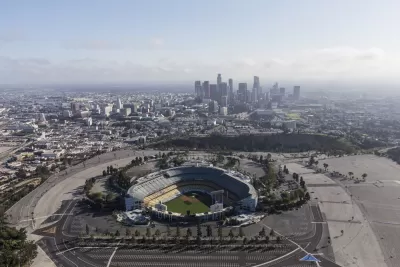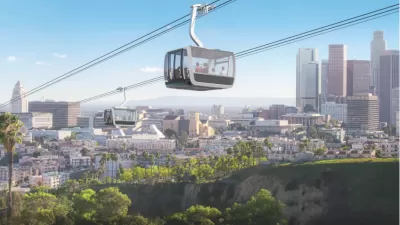A closer look at a plan for Los Angeles linking Dodger Stadium to the subway points to the proposal’s many flaws.

Not long after revealing a proposal for high-speed rail to the O’Hare Airport in Chicago, Elon Musk moved on to Los Angeles and unveiled his grand plan to construct a tunnel connecting Dodger Stadium to the Red Line. Alon Levy examines The Boring Company’s plan and concludes that its many problems outweigh any potential benefits.
For one, says Levy, the cost estimates seem low and based on questionable assumptions, particularly because any Red Line terminus would be located in a dense area with complex construction needs. In addition, the proposed plan would not move enough riders:
By Boring's own admission, the line would only have enough space for 2.5 percent of Dodger Stadium's capacity. The small tunnel diameter and very small vehicles ensure that capacity would be limited from the start with no room for expansion.
Levy also argues that the proposed route to the Red Line does not make sense when Union Station, just over a mile from Dodger Stadium, already serves a multitude of rail lines. Achieving maximum benefits for a tunnel such as this needs to be an important consideration, says Levy:
Dodger Stadium-Vermont is not really useful except for those traveling from Hollywood or North Hollywood to Dodger Stadium; the tunnel would be unused except for a short period before and after a Dodgers home game. It might be useful to Musk as a proof of concept in the unlikely event he can fulfill his promise of cheap construction, but it cannot make money with such low utilization.
In the end, Los Angeles needs to reject a project that is not likely to succeed, concludes Levy. “If Musk wants to bore tunnels, he should do so under private property and side streets and pay the owners a negotiated fee rather than getting access to a potential metro corridor,” he adds.
FULL STORY: Elon Musk's Solution for Dodger Stadium Traffic is Full of Holes

Planetizen Federal Action Tracker
A weekly monitor of how Trump’s orders and actions are impacting planners and planning in America.

Congressman Proposes Bill to Rename DC Metro “Trump Train”
The Make Autorail Great Again Act would withhold federal funding to the system until the Washington Metropolitan Area Transit Authority (WMATA), rebrands as the Washington Metropolitan Authority for Greater Access (WMAGA).

The Simple Legislative Tool Transforming Vacant Downtowns
In California, Michigan and Georgia, an easy win is bringing dollars — and delight — back to city centers.

The States Losing Rural Delivery Rooms at an Alarming Pace
In some states, as few as 9% of rural hospitals still deliver babies. As a result, rising pre-term births, no adequate pre-term care and "harrowing" close calls are a growing reality.

The Small South Asian Republic Going all in on EVs
Thanks to one simple policy change less than five years ago, 65% of new cars in this Himalayan country are now electric.

DC Backpedals on Bike Lane Protection, Swaps Barriers for Paint
Citing aesthetic concerns, the city is removing the concrete barriers and flexposts that once separated Arizona Avenue cyclists from motor vehicles.
Urban Design for Planners 1: Software Tools
This six-course series explores essential urban design concepts using open source software and equips planners with the tools they need to participate fully in the urban design process.
Planning for Universal Design
Learn the tools for implementing Universal Design in planning regulations.
Smith Gee Studio
City of Charlotte
City of Camden Redevelopment Agency
City of Astoria
Transportation Research & Education Center (TREC) at Portland State University
US High Speed Rail Association
City of Camden Redevelopment Agency
Municipality of Princeton (NJ)




























